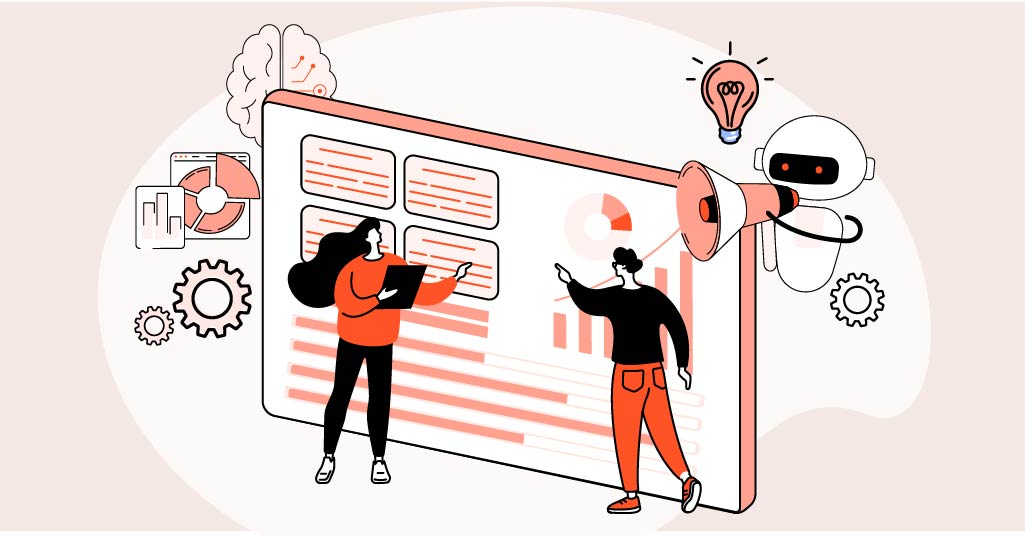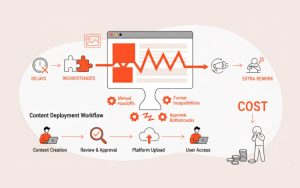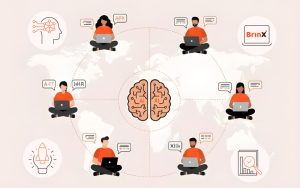There’s a quiet revolution reshaping how learning is built. It’s happening in the subtle space between creativity and technology, where instructional design meets intelligence.
For years, we’ve poured hours into building courses slide by slide, aligning objectives, storyboarding every detail, and manually creating assessments. Although the labor was meticulous and even tedious, it was also significant. Then, artificial intelligence (AI) in eLearning emerged as a collaborator rather than a disruptor.
Let’s be clear: AI didn’t come to replace instructional designers. It came to remove the friction. It’s the co-designer that handles the repetitive so we can focus on the reflective, automating layouts, generating assessments, and surfacing insights that once took days to find.
I remember an early project where a team used AI to analyze learner data mid-course. The system flagged that learners were disengaging halfway through. Within hours, the designer adjusted pacing and interactions, changes that used to take weeks of post-launch evaluation. That’s not science fiction. That’s happening now.
AI in eLearning is transforming our role from course builders to experience architects. And platforms like BrinX.ai are proving what’s possible when AI and instructional design truly collaborate.

The Evolution of Instructional Design
Historically, instructional design has combined narrative with structure. Teams were able to create successful learning experiences through transparent, repeatable procedures with the use of models such as ADDIE and SAM.
But today, learners expect more. They want personalization, adaptability, and relevance, not static modules. AI makes this possible by turning traditional frameworks into living systems that learn, predict, and adapt.
Imagine an intelligent version of SAM (the Successive Approximation Model), with learner data guiding automated iterations. These days, AI-powered solutions monitor interaction trends, suggest design modifications, and even forecast the most effective content. It’s about more intelligent design, not just quicker development.
This is the shift that instructional designers are going through, one that builds on their experience rather than diminishes it.

Why AI Isn’t Replacing Designers, It’s Empowering Them
A widespread concern is that AI will eventually supplant human ingenuity. However, in reality, AI is allowing it to expand.
Rather of wasting hours on quiz logic or slide layout, designers can now concentrate on what really counts: connecting learning to behavior change, impactful narrative, and creating motivating experiences.
AI in eLearning is reshaping the human-AI partnership:
AI handles the mechanical: tagging, sequencing, assessments, layout optimization.
Designers handle the meaningful: empathy, ethics, learner engagement, tone, and culture.
It’s the same logic behind Gagne’s 9 Events of Instruction AI can help “present the content” and “provide feedback,” but only a designer can “gain attention” and “foster relevance.” The human remains at the center of every learning story.

Real-World Use Cases of AI in Instructional Design
Here’s how AI is already transforming learning design in action:
AI-Generated Assessments
Instead of manually building test banks, AI maps learning objectives to Bloom’s Taxonomy and auto-generates assessments, ensuring cognitive depth and variety without hours of manual work.
Automated Layout and Pacing
BrinX.ai uses AI to automatically generate course layouts, pacing logic, and instructional flow. Designers can instantly see how the course structure supports objectives, freeing up time for creativity and scenario-building.
Adaptive Learning Journeys
AI tailors each learner’s journey. If someone struggles with a concept, the system can surface a refresher module or visual simulation, applying Cognitive Load Theory to reduce overwhelm.
Predictive Insights
Through the analysis of assessment and engagement data, AI identifies what works and what doesn’t. Instead of waiting for post-course assessments, designers have the ability to modify material in the middle of the program.
Versioning and Governance
One of BrinX.ai’s most impressive features is its automated version control. Every update is tracked, every iteration documented, ensuring compliance and consistency across teams.
AI is turning the design process itself into a living, learning system.

BrinX.ai: Where AI and Instructional Design Truly Connect
Platforms like BrinX.ai aren’t just “using AI,” they’re redefining how instructional design happens.
Here’s how BrinX.ai brings the theory to life:
-
AI-Driven Course Logic: Automatically structures layouts and pacing using learning science frameworks. Designers can instantly visualize cognitive flow.
-
Smart Assessment Generator: Develops adaptive tests that are correlated with learning objectives and Bloom’s levels.
-
Built-In Version Governance: Maintains control over compliance for instructional teams by keeping track of each edit, author, and approval trail.
-
Seamless Packaging: Instantly exports SCORM/xAPI packages with integrated logic and version data.
This is AI with instructional empathy technology that understands how humans learn and how designers think. It’s the partnership instructional design that has been waiting for.

The Challenges and Ethics of AI in eLearning
The rise of AI brings promise, but also responsibility. Operational and ethical factors are crucial:
-
Bias and Fairness: To avoid biased learning outputs, AI must be taught on a variety of data.
-
Transparency: Students should be aware of how AI affects their learning.
-
Data Privacy: Since data is produced throughout every encounter, data protection regulations must advance along with AI.
-
Human Oversight: In order to ensure that AI supports learning rather than the other way around, designers must continue to be the moral compass.
Carefully applied, AI in eLearning increases engagement and equity. Without oversight, it risks becoming another checkbox tool. The difference lies in human leadership.

Instructional Design Models Reimagined by AI
Classic frameworks like ADDIE, SAM, and Kirkpatrick’s Four Levels are being supercharged by AI:
-
ADDIE becomes a continuous loop, AI analytics flow back into each stage automatically.
-
SAM thrives on AI-powered iteration, instant prototypes, and data-driven refinements.
-
Kirkpatrick’s Evaluation Model evolves into live dashboards showing behavioral impact in real time.
-
Gagne’s Events blend automation and artistry, AI supports delivery, while humans craft engagement.
AI doesn’t replace design theory. It revitalizes it for the next generation of learning.

What’s Next for AI in eLearning (2025 and Beyond)
In the future, AI in eLearning will develop in three main ways:
Conversational Learning Experiences: AI-powered tutors and chat-based instruction that are seamlessly incorporated into classes.
Generative Storytelling: AI assists designers in creating micro-scenarios and branching narratives that are tailored to the individual learner.
Predictive Curriculum Design: AI helps L&D teams proactively eliminate skill gaps by anticipating learner requirements before they materialize.
Instructional design will increasingly be about orchestration, shaping ecosystems, not just modules. Designers won’t disappear; they’ll lead.

Practical Takeaways for Designers and L&D Teams
-
Start small, let AI handle one workflow like assessment generation.
-
Focus on creativity and empathy, which only humans can do.
-
Use data not as judgment but as insight.
-
Choose platforms like BrinX.ai that balance automation with governance.
AI isn’t here to replace instructional designers. It’s here to make their brilliance more visible.
Conclusion
The relationship between the learner and the material, the designer and the approach, the aim and the effect, has always been central to instructional design.
Deeper, quicker, and more intelligent connections are being made in eLearning thanks to AI. It is changing designers into strategists, converting static courses into dynamic experiences, and granting creativity the space it has long deserved.
With BrinX.ai, that future isn’t theoretical, it’s operational. It’s the living proof that when humans and AI co-design, learning becomes not just efficient, but extraordinary.
External Resource: For further reading on AI’s impact on the learning ecosystem, visit Harvard Business Review’s Future of Workplace Learning.

FAQs
What is AI in eLearning?
AI in eLearning refers to the use of artificial intelligence tools and models to automate, personalize, and optimize instructional design and learning delivery.
How is AI transforming instructional design?
AI is reshaping instructional design by automating repetitive tasks, generating data-driven insights, and enabling adaptive learning paths so designers can focus on creativity and strategy.
Can AI replace instructional designers?
No. AI enhances instructional design by managing mechanical tasks, allowing designers to invest their time in creativity, empathy, and alignment with business goals.
What are the benefits of using AI in eLearning?
Key benefits include faster course creation, adaptive personalization, smarter assessments, better learner analytics, and continuous improvement through feedback loops.
How does BrinX.ai use AI for instructional design?
BrinX.ai automates course structure, pacing, and assessment logic using AI-driven design principles, while maintaining strong version control and governance.
What challenges come with AI in eLearning?
The main challenges include ethical oversight, data bias, intellectual property questions, and ensuring human judgment remains central in the design process.
What instructional design models work best with AI?
Models like ADDIE, SAM, and Gagne’s 9 Events integrate seamlessly with AI, turning static frameworks into dynamic, data-responsive design systems.
How can AI improve learner engagement?
AI supports adaptive content, predictive nudges, and personalized reinforcement, aligning with motivation models like ARCS and Self-Determination Theory.
Is AI-driven learning content ethical?
It can be, when guided by transparency, inclusivity, and diverse data sets, ensuring that algorithms serve learning rather than bias it.
What’s next for AI in instructional design?
Expect AI to drive conversational learning, generative storytelling, and predictive analytics that anticipate learner needs before they arise.

Soft Skills Deserve a Smarter Solution
Soft skills training is more than simply information. It is about influencing how individuals think, feel, and act at work, with coworkers, clients, and leaders. That requires intention, nuance, and trust.






